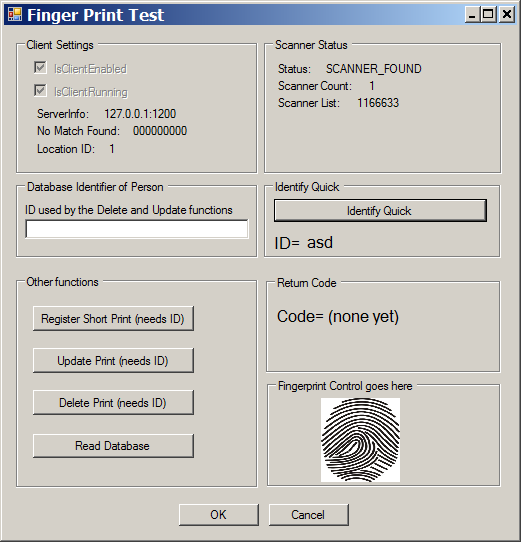Fingerprint SDK is a Software Development Kit (SDK) that provides a flexible platform for the development and programming of biometric fingerprint recognition into any application. This is one of the best biometric SDK components for authorization systems, transaction systems, time and attendance, point-of-sale identification, physical access control, and any other application that can. Fingerprint Sdk Download; Fingerprint Sdk 2009 Serial Key Code; Free Fingerprint Sdk; Fingerprint Sdk 2009 Product Key; GrFinger is Griaule Biometrics’ fingerprint recognition software development kit(SDK). Fingerprint Software Development Kit also supports many programming languages such as Java, Delphi Visual Basic, FoxPro, C.NET, Perl.
Fingerprint identification for stand-alone or Web solutions
VeriFinger is a fingerprint identification technology designed for biometric systems developers and integrators. The technology assures system performance with fast, reliable fingerprint matching in 1-to-1 and 1-to-many modes.

Available as a software development kit that allows development of stand-alone and Web-based solutions on Microsoft Windows, Linux, macOS, iOS and Android platforms.
Download demo application.
Download 30-day SDK Trial.
Download Brochure (PDF).
- 1500+ end-user product brands in 100+ countries used the VeriFinger algorithm over the past 23 years.
- Full NIST MINEX compliance, FpVTE and FVC awards since 2000.
- Rolled and flat fingerprint matching that is tolerant to fingerprint translation, rotation and deformation.
- Compact fingerprint template and unlimited database size.
- Available as multiplatform SDK that supports multiple scanners and multiple programming languages.
- FingerCell SDK for embedded platforms, like microcontrollers, optionally available.
- Reasonable prices, flexible licensing and free customer support.
Free Fingerprint Sdk

In 1998 Neurotechnology developed VeriFinger, a fingerprint identification technology designed for biometric system integrators. Since that time, Neurotechnology has released more than 10 major and minor versions of the VeriFinger, providing most powerful fingerprint recognition algorithms to date. Numerous awards in competitions and technology evaluations, including FVC and FpVTE, have been received by VeriFinger.
The VeriFinger algorithm is based on deep neural networks and follows the commonly accepted fingerprint identification scheme, which uses a set of specific fingerprint points (minutiae) along with a number of proprietary algorithmic solutions that enhance system performance and reliability. Some are listed below:
Fingerprint Scanner With Sdk

Fingerprint Sdk 2009 Download Free Download
- Rolled and flat fingerprints matching. The VeriFinger algorithm matches flat-to-rolled, flat-to-flat or rolled-to-rolled fingerprints with a high degree of reliability and accuracy, as it is tolerant to fingerprint deformations. Rolled fingerprints have much bigger deformation due to the specific scanning technique (rolling from nail to nail) than those scanned using the 'flat' technique. Conventional 'flat' fingerprint identification algorithms usually perform matching between flat and rolled fingerprints less reliably due to the mentioned deformations of rolled fingerprints.
- Tolerance to fingerprint translation, rotation and deformation. VeriFinger's proprietary fingerprint template matching algorithm is able to identify fingerprints even if they are rotated, translated, deformed and have only 5 - 7 similar minutiae (usually fingerprints of the same finger have 20 - 40 similar minutiae) and matches up to 40,000 flat fingerprints per second (see technical specifications for more details). Also, the matching algorithm has a special mode for the cases when some fingerprint records have incorrect resolution.
- Identification capability. VeriFinger functions can be used in 1-to-1 matching (verification), as well as 1-to-many mode (identification).
- Image quality determination. VeriFinger is able to ensure that only the best quality fingerprint template will be stored into database by using fingerprint image quality determination during enrollment.
- Spoof fingerprint detection. A deep learning based scanned fingerprint image classification is used to separate live/non-live fingerprints to detect finger presentation attack. This feature covers spoofing attempts performed with ecoflex, wood glue, latex and gelatin and is useful for fraud identification.
- Adaptive image filtration. This algorithm eliminates noises, ridge ruptures and stuck ridges for reliable minutiae extraction – even from poor quality fingerprints – with a processing time of 0.6 seconds.
- Features generalization mode. This fingerprint enrollment mode generates the collection of generalized fingerprint features from a set of fingerprints of the same finger. Each fingerprint image is processed and features are extracted. Then the features collection set is analyzed and combined into a single generalized features collection, which is written to the database. This way, the enrolled features are more reliable and the fingerprint recognition quality considerably increases.
- Compact fingerprint template. VeriFinger allows to configure the number and size of fingerprint features in a fingerprint template. Combined with unlimited database size, this capability allows to optimize target system size and performance.
- Scanner-specific algorithm optimizations. VeriFinger 12.1 includes algorithm modes that help to achieve better results for the supported fingerprint scanners.